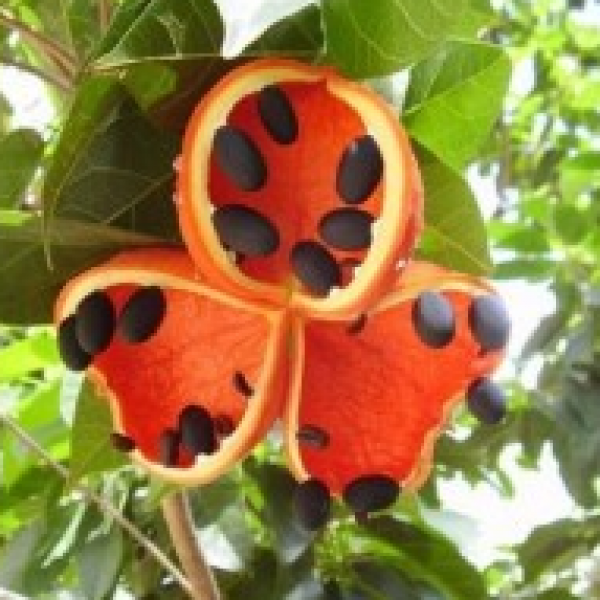This image is for reference purpose only, Photo May Slightly Different From Actual Item in Terms of Color Due to the Lighting During Photo Shooting or the Monitor's Display.
Sterculia lychnophora
Sterculia lychnophora Hance (Malva nut tree or Taiwan sweet gum tree) is a species of tree in the genus Sterculia, native to mainland Southeast Asia. Its seed is used in traditional Chinese medicine as a coolant and it also used for gastrointestinal disorders and for soothing the throat.
In China, malva nut is used in tea as well by mixing with other ingredients such as sugar candy, red date, haw, liquorice, chrysanthemun flower, lilyturfroot, and jasmine tea. The advantage of such tea is believed to reduce the "hotness" of the body, and nurture the body.
The flesh surrounding the dried seeds swells to eight times its original volume when soaked in water, forming an irregularly shaped, reddish gelatinous mass.
According to the Chinese medicine, the use of "sterculia lychnophora" is to remove heat from the lung, to cure sore throat, to counteract toxicity, and to relax the bowels. Therefore, when a person has symptoms such as hoarseness of voice, dry cough, and sore, dry throat due to heat in the lung; constipation with headache and bloodshot eyes should consume malva nut by putting it into boiling water.
What is malva?
Malva, as a matter of fact, refers to a genus in the family called Malvaceae. Based on the statistics there are around 25 to 30 species of plants in this genus, which share the name mallow with a number of other members in the family Malvaceae. However, medicinally malva nut refers to the mature seeds from Sterculia lychnophora Hance or Sterculia scaphigera Wall, which is a member in the family Sterculiaceae. Hence, other names of this herb include Boat Sterculia Seed, Boat-fruited Scaphium Seed, sterculia Scaphigera Seed, semen scaphii lychnophori, sterculia seed, Semen Sterculiae Scaphigerae, Malva nut tree seed, Taiwan sweet gum tree seed, and more. As you can see now, malva and sterculia are different genera. So, don’t confuse this medicinal plant with Malva alcea, Malva verticillata, and other Malva plants even though its nuts are named after malva. Malva nuts are mainly produced in Thailand, Cambodia, Malaysia, Indonesia, Vietnam, and India. It is usually collected from April to June when the fruits become ripe and cracked. And the seeds are token and dried in the sun.
Sterculia lychnophora is a deciduous tree which is from 30 to 40 meters in height. Rough bark is slightly striate. Alternate leaves are with 5-15cm petiole; blade is leathery, smooth and hairless, oval or elliptical-lanceolate, 10 to 20cm long, 6 to 14cm wide, and with obtuse or acute apex, rounded or almost truncate base, and entire margin. It has male, female, and perfect (hermaphrodite) flowers, which form acrogenous or axillary panicles; bell-shaped calyx is persistent and with lanceolate lobes; astroid flowers stretch; male flowers are with 10-15 stamens, or up to 30 in rare case; female flowers are with 1 pistil and ovary, which consists of 5 tomentose carpels. Follicles are 1 to 5, grown in stems, 18 to 24cm long, initially puberulous but soon glabrous, and with boat-like 5-6cm base that cracks before the maturity. Seeds are fusiform or obovate, 18 to 25mm in diameter, dark brown, and with rugose surface; large cotyledons are 12mm in length, 10mm in width, semicircular, and with rich endosperm.
Outer layer of seed contains bassorin. Peel contains 15.06% galactose and 24.7% pentaglucose (mainly arabinose).
Nut of malva benefits
Medicinally it is first recorded in Ben Cao Gang Mu Shi Yi (Supplements to Compendium of Materia Medica). It is named Pang Da Hai, literally “fat sea”, because its cracked rind will expand and almost fill the entire cup once it is placed in boiling water. So, plenty of water is required when this nut is cooked or soaked.
From the perspective of traditional Chinese medicine, it has two major healing properties. On the one hand, it can relax the bowels, especially constipation caused by internal fire; on the other hand, it cools and disperses lung qi. Because of that, firstly it can be used for the treatment of acute pharyngitis and tonsillitis induced by wind-heat attacking the lung. In this case, 3 to 5 nuts soaking and making tea is highly recommended. Secondarily, it relieves sore throat after flu shot or wind-heat cold induced fever, scratchy sore throat, dry cough without phlegm, voice loss, and mild or extremely swollen sore throat, and so on. In this case, making tea with 5 nuts and 3 grams Gan Cao (licorice root) is a good try. Besides of making tea, it can be still made into refreshing summer desserts and iced drinks for sore throat, chronic pharyngitis, phlegm, voice loss, etc. By the way, keep in mind to stop it no matter it works or not after it has been drunk for 2 straight days.
Niranjan Phal (Sterculia Lychnophora) plant
- Live plant along with plastic pot
- plants height with pot is 1-2 feet and pot size is 5 icnhes diameter.
- plants nature is outdoor, loves full sun, less watering
- Grows till 30 feet, best landscaping plant and avenue tree
